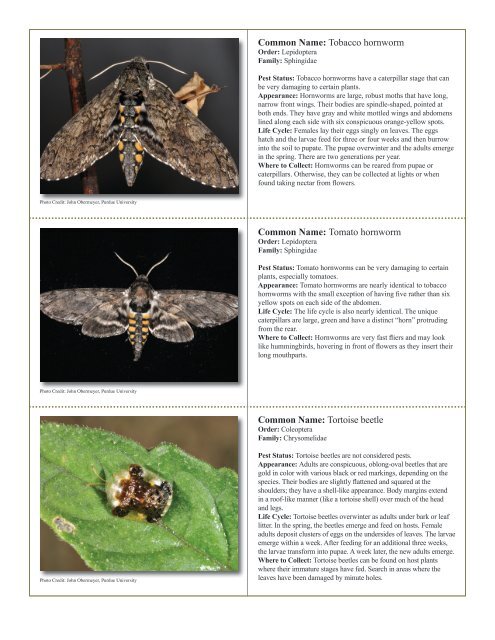to download pdf - Purdue Extension Entomology - Purdue University
to download pdf - Purdue Extension Entomology - Purdue University
to download pdf - Purdue Extension Entomology - Purdue University
Create successful ePaper yourself
Turn your PDF publications into a flip-book with our unique Google optimized e-Paper software.
Common Name: Tobacco hornworm<br />
Order: Lepidoptera<br />
Family: Sphingidae<br />
Pest Status: Tobacco hornworms have a caterpillar stage that can<br />
be very damaging <strong>to</strong> certain plants.<br />
Appearance: Hornworms are large, robust moths that have long,<br />
narrow front wings. Their bodies are spindle-shaped, pointed at<br />
both ends. They have gray and white mottled wings and abdomens<br />
lined along each side with six conspicuous orange-yellow spots.<br />
Life Cycle: Females lay their eggs singly on leaves. The eggs<br />
hatch and the larvae feed for three or four weeks and then burrow<br />
in<strong>to</strong> the soil <strong>to</strong> pupate. The pupae overwinter and the adults emerge<br />
in the spring. There are two generations per year.<br />
Where <strong>to</strong> Collect: Hornworms can be reared from pupae or<br />
caterpillars. Otherwise, they can be collected at lights or when<br />
found taking nectar from flowers.<br />
Pho<strong>to</strong> Credit: John Obermeyer, <strong>Purdue</strong> <strong>University</strong><br />
Common Name: Toma<strong>to</strong> hornworm<br />
Order: Lepidoptera<br />
Family: Sphingidae<br />
Pest Status: Toma<strong>to</strong> hornworms can be very damaging <strong>to</strong> certain<br />
plants, especially <strong>to</strong>ma<strong>to</strong>es.<br />
Appearance: Toma<strong>to</strong> hornworms are nearly identical <strong>to</strong> <strong>to</strong>bacco<br />
hornworms with the small exception of having five rather than six<br />
yellow spots on each side of the abdomen.<br />
Life Cycle: The life cycle is also nearly identical. The unique<br />
caterpillars are large, green and have a distinct “horn” protruding<br />
from the rear.<br />
Where <strong>to</strong> Collect: Hornworms are very fast fliers and may look<br />
like hummingbirds, hovering in front of flowers as they insert their<br />
long mouthparts.<br />
Pho<strong>to</strong> Credit: John Obermeyer, <strong>Purdue</strong> <strong>University</strong><br />
Common Name: Tor<strong>to</strong>ise beetle<br />
Order: Coleoptera<br />
Family: Chrysomelidae<br />
Pho<strong>to</strong> Credit: John Obermeyer, <strong>Purdue</strong> <strong>University</strong><br />
Pest Status: Tor<strong>to</strong>ise beetles are not considered pests.<br />
Appearance: Adults are conspicuous, oblong-oval beetles that are<br />
gold in color with various black or red markings, depending on the<br />
species. Their bodies are slightly flattened and squared at the<br />
shoulders; they have a shell-like appearance. Body margins extend<br />
in a roof-like manner (like a <strong>to</strong>r<strong>to</strong>ise shell) over much of the head<br />
and legs.<br />
Life Cycle: Tor<strong>to</strong>ise beetles overwinter as adults under bark or leaf<br />
litter. In the spring, the beetles emerge and feed on hosts. Female<br />
adults deposit clusters of eggs on the undersides of leaves. The larvae<br />
emerge within a week. After feeding for an additional three weeks,<br />
the larvae transform in<strong>to</strong> pupae. A week later, the new adults emerge.<br />
Where <strong>to</strong> Collect: Tor<strong>to</strong>ise beetles can be found on host plants<br />
where their immature stages have fed. Search in areas where the<br />
leaves have been damaged by minute holes.
















